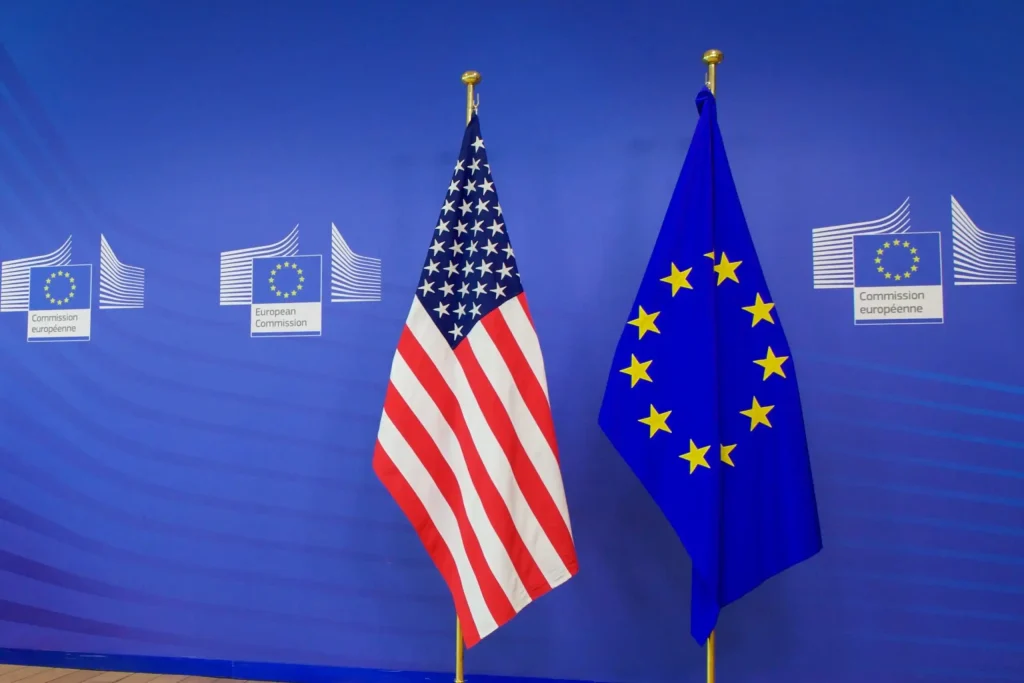In a significant development aimed at calming rising trade tensions, the United States and the European Union reached an agreement on Sunday, July 27, to introduce a 15% tariff on the majority of EU exports, including automobiles. This compromise replaces a previously threatened 30% tariff that was scheduled to take effect on August 1, 2025, and helps steer both sides away from a potentially damaging transatlantic trade conflict.
U.S. President Donald J. Trump and European Commission President Ursula von der Leyen finalized the terms of the agreement during a high-stakes meeting in Scotland, just days before the looming deadline. The two leaders reportedly held extended talks to address months of brewing disagreement over trade balances, market access, and tariffs.
Urgent Diplomacy Avoids Severe Tariffs
The weekend negotiations marked the culmination of a tense period of diplomatic activity between the two economic giants. Leading up to the agreement, both sides exchanged threats and prepared retaliatory measures that could have triggered a cycle of escalating tariffs and disrupted trade flows across the Atlantic.
Just days before the agreement was reached, the European Union had finalized a plan to introduce retaliatory tariffs targeting U.S. goods worth approximately €93 billion ($109 billion). These measures were scheduled to be implemented in phases beginning on August 7, with rates as high as 30% on a wide spectrum of American exports ranging from agricultural products to industrial goods.
Although European leaders had remained cautiously optimistic about the potential for a peaceful resolution, they had simultaneously taken steps to ensure they were prepared to respond if talks fell apart. The dual-track strategy underscored the seriousness of the dispute and the real risk of economic fallout.
Details of the Tariff Deal
According to sources familiar with the agreement, the 15% tariff rate will apply to most European goods exported to the United States, including the automotive sector—a long-standing flashpoint in U.S.–EU trade relations. However, the deal also includes important exemptions that mirror previous trade arrangements the U.S. government has established with other allies, such as Japan.
Sectors that will be exempt from the new tariff structure include commercial aircraft, specific pharmaceutical products, select types of lumber, and certain categories of agricultural exports. These exclusions reflect mutual recognition of strategic industries and are intended to avoid disruptions in sectors deemed sensitive by both parties.
The European Union, in return, is expected to make a series of concessions, which may include reducing its own import duties on select American goods. While the specifics of these concessions have not yet been fully disclosed, officials indicated they would contribute to a more balanced trade relationship between the two economies.
Preventing a Transatlantic Trade Breakdown
The agreement has been widely viewed as a crucial step in preventing a full-scale trade war between two of the world’s largest economic powers. Trade tensions between Washington and Brussels have been simmering for years, with disputes over subsidies, digital services taxes, environmental standards, and tariffs repeatedly testing the resilience of transatlantic relations.
The threat of a 30% U.S. tariff on European imports had triggered alarm across the EU, with many industries warning of job losses, supply chain disruptions, and price increases if the measures were enacted. The auto sector, in particular, stood to suffer heavily from the imposition of steep tariffs, which would have made European vehicles significantly more expensive in the American market.
By agreeing to a 15% tariff instead, both sides have signaled a willingness to compromise while avoiding the worst-case scenario. Analysts suggest that the decision to settle at a lower rate reflects not only economic pragmatism but also a broader desire to preserve long-term cooperation on global trade and regulatory standards.
A Win for Diplomacy and Trade Stability
Observers have praised the agreement as a diplomatic victory that buys both sides time to continue working on a more comprehensive and sustainable trade framework. It also demonstrates the importance of high-level engagement and face-to-face diplomacy in resolving complex economic disputes.
President Trump, speaking after the agreement was finalized, emphasized the importance of reciprocity in trade relations. He noted that while the United States remains committed to protecting American industries, it also values partnerships that promote mutual economic growth.
“We are committed to ensuring fair trade that benefits American workers and companies, but we also want strong relationships with our allies,” he said. “This agreement with the European Union helps accomplish both goals.”
President von der Leyen also expressed satisfaction with the outcome, noting that it reflects the EU’s commitment to de-escalation and constructive dialogue. She reaffirmed the bloc’s intention to work closely with the U.S. to strengthen economic ties and address other unresolved trade issues in the coming months.
Echoes of Previous Trade Challenges
The compromise bears resemblance to past disputes between the U.S. and its trading partners, where last-minute negotiations have averted harsh trade penalties. In recent years, disagreements over steel and aluminum tariffs, aircraft subsidies, and digital services taxes have sparked multiple rounds of tension and retaliatory measures.
The new tariff deal may be a step toward reducing the frequency of such confrontations, particularly if both sides follow through on commitments to greater transparency, fair competition, and consistent enforcement of trade agreements.
Still, some trade experts warn that the agreement, while helpful in the short term, does not fully resolve underlying issues that have plagued transatlantic trade relations. Concerns remain over regulatory misalignments, industrial subsidies, and disagreements surrounding the digital economy.
What Comes Next?
With the immediate threat of a trade war temporarily defused, attention now turns to the next phase of U.S.–EU trade discussions. Negotiators are expected to begin working on broader agreements covering digital trade, environmental standards, and subsidies, with the goal of creating a modernized transatlantic trade framework that reflects the evolving global economy.
Additionally, both sides have agreed to establish a joint working group that will monitor the implementation of the new tariff arrangement and explore opportunities for further tariff reductions in the future. This initiative is seen as a way to promote ongoing dialogue and prevent the recurrence of sudden policy shifts that could destabilize markets.
Industry groups from both continents have urged policymakers to build on this momentum and pursue a more integrated and forward-looking trade agenda. They argue that a stable and predictable trade environment is essential for long-term investment, innovation, and job creation.
Final Thoughts
The 15% tariff agreement between the United States and the European Union marks a significant turning point in a months-long standoff that threatened to spiral into an economic conflict with global repercussions. By choosing compromise over confrontation, both sides have opened the door to renewed cooperation and a more balanced trade relationship.
While the journey toward comprehensive trade harmony remains ongoing, this agreement serves as a reminder of the power of diplomacy, dialogue, and strategic negotiation in shaping the future of global commerce.












